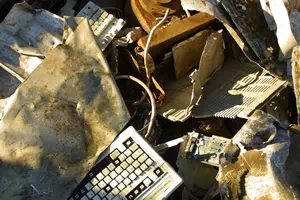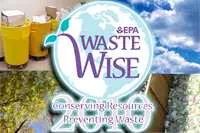|
 Waste Reduction—Solid Waste Disposal Waste Reduction—Solid Waste Disposal
This section addresses waste reduction for healthcare facility solid wastes. For the purpose of this discussion, solid waste refers to what we think of as "municipal waste" and does not include hazardous or regulated medical wastes.
 |
| WasteWise is a voluntary EPA program through which organizations eliminate costly solid waste, benefiting their bottom line and the environment. |
Characterizing the solid waste stream
The origin and character of solid wastes generated at healthcare facilities varies widely, depending on the type of facility (i.e., veterinary clinic, human hospitals, laboratory, dental office, etc.). For example, veterinary clinics and hospitals generate most of their solid waste as a consequence of patient care, while laboratory solid waste consists more of packaging from purchased chemicals and equipment. Although the majority of the information in this section relates directly to clinic/hospital solid waste, the information for certain departments, such as purchasing, offices, and custodial services is applicable to nearly all healthcare facilities.
For most veterinary clinics and human hospitals the largest components of the solid waste stream are paper (especially cardboard, mixed paper, newspapers, and high-grade paper), food waste, and disposable linens (a combination of paper and other materials), plastics (especially film plastic), and glass. Yard trimmings may also be a significant percentage of the waste stream if a facility has a large landscaped area.
Setting goals for solid waste reduction
Short of eliminating patients, visitors and staff, healthcare facilities are going to generate solid waste -- no matter how much effort is put into waste prevention and recycling, there will be a residual quantity that cannot be eliminated. Therefore, a good question is: how high to set the bar? The answer depends on many factors, some of which you can affect (like levels of enthusiasm), and others that you will have less control over. Here are some factors to consider when setting goals:
- Starting point -- What existing waste reduction programs are in effect? If you are starting at square one, then expect major reductions. If you already have successful prevention or recycle programs in place, it will be harder to achieve a high percentage reduction in the future.
- Budget -- Solid waste reduction will save money, but some expenditure must be expected – as the old saying goes, "to make money you have to spend money."
- Availability of markets for recyclables – All areas of the U.S. have markets for paper, glass and plastic, but other wastes, such as used carpeting, furniture or office equipment, may be difficult to recycle in certain locales.
Keeping in mind that there is bound to be some significant case-to-case variability, it is possible to roughly estimate your potential success by looking at case studies that document the achievements of other healthcare facilities. Below, you will find links to documents that describe real life success stories at human hospitals.

Solid waste reduction methods
Solid waste reduction methods, including prevention and recycling schemes, are listed below by department along with some applicable references and case studies. To be successful and sustainable, as with any program, solid waste reduction must be implemented in an organized and systematic way. The program must involve management, purchasing, and staff in various departments.
Purchasing
- Implement Environmentally Preferable Purchasing (EPP).
- Buy in bulk whenever possible; it saves packaging.
- Select or ask vendors to follow packaging preference criteria:
- No packaging or minimal packaging.
- Consumable, returnable, refillable, reusable packaging.
- Reuse and/or recyclable packaging/recycled material in packaging.
- Improve ordering practices so perishable products don't become outdated and unusable.
- Cut down on multiple subscriptions of medical publications by asking staff to share journals and magazines.
Custodial Services
- Eliminate plastic trash bag liners in administrative areas.
- Buy most cleaning substances in 55-gallon drums that are refilled by the supplier.
- Use concentrated cleaning solutions that staff dilutes to application strength as needed.
- Use washable dust mop heads instead of disposable ones.
- Keep items that can be recycled or that must be disposed of as a dangerous waste out of the garbage/sewer/septic.
- Wastes and recyclables should be stored separately.
- Minimize packaging by buying chemicals in bulk, in concentrated form, to dilute at time of use.
- Use refillable, automatic soap and lotion dispensers, bulk containers for cleaning chemicals.
- Use air hand-dryers instead of paper towels.
Medical/Surgical Supplies
- Eliminate unused items from custom surgical packs (once a pack is opened, unused items are discarded).
- Consider switching from disposable to reusable medical instruments (e.g., stainless steel trays, laparoscopic instruments).
- Contact the manufacturer when one item in a surgical tray is causing the whole pack to outdate early (e.g., tetracaine in a spinal tray).
- Purchase washable surgical and isolation gowns and sterilization trays.
- Mend gown ties so they last longer.
- Convert surgical drapes into biopsy cloths.
- Sanitize and reuse plastic fracture pans.
- Sanitize and reuse graduated measuring containers.
- Recycle single use devices.
Offices
- Assess need for photocopies and print only what is needed.
- Increase double-sided copying in central copy areas.
- Keep records on microfiche or double-side copies for paper documents.
- Consolidate multiple forms and reduce extra copies.
- Keep report and memo writing to a minimum and limit distribution.
- Reuse paper only used on one side.
- Purchase recycled paper and print stationery, business cards, etc. on recycled paper.
- Find a materials exchange program for used file cabinets, computer equipment, desks, etc.
Landscaping
- Use mulching mowers and leave grass clippings on the lawn so they can decompose naturally.
- Landscape using plants that grow slowly or have enough space so they do not need to be constantly trimmed.
- Compost yard wastes on- or off-site. Use compost and mulching for pest reduction.
Laundry
- Purchase the most energy-efficient equipment available.
- Re-use and recycle. Use reusable surgical items (e.g., gowns, diapers, coveralls, drapes, mattress pads for human hospitals) instead of disposable items when available.
- Keep wastes and recyclables separate. Don't mix waste materials into linens for disposal.

|

